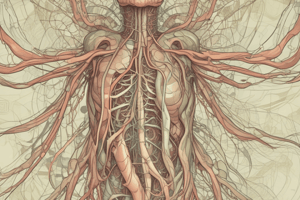Podcast
Questions and Answers
Where are the three large clusters of superficial lymph nodes located?
Where are the three large clusters of superficial lymph nodes located?
The cervical, inguinal, and axillary regions
Which tonsil is located in the posterior wall of the nasopharynx and is referred to as the adenoids if it is enlarged?
Which tonsil is located in the posterior wall of the nasopharynx and is referred to as the adenoids if it is enlarged?
pharyngeal tonsil
Functions of the spleen include all of those below EXCEPT ________.
Functions of the spleen include all of those below EXCEPT ________.
forming crypts that trap bacteria
What anatomical area(s) is/are protected by the tubal tonsils?
What anatomical area(s) is/are protected by the tubal tonsils?
Which of the following mechanisms is NOT used to propel lymph through lymphatic vessels?
Which of the following mechanisms is NOT used to propel lymph through lymphatic vessels?
Lymph from the right leg ultimately is delivered to which duct in the thoracic region?
Lymph from the right leg ultimately is delivered to which duct in the thoracic region?
Which statement correctly describes the origin of lymph fluid?
Which statement correctly describes the origin of lymph fluid?
When the lymphatic structures of a limb are blocked due to tumors, the result is ________.
When the lymphatic structures of a limb are blocked due to tumors, the result is ________.
Select the correct statement about lymphocytes.
Select the correct statement about lymphocytes.
Lymphocytes reside temporarily in lymphoid tissue, then move to other parts of the body.
Lymphocytes reside temporarily in lymphoid tissue, then move to other parts of the body.
Small secondary lymphoid organs, which cluster along lymphatic vessels, are termed ________.
Small secondary lymphoid organs, which cluster along lymphatic vessels, are termed ________.
Lymph leaves a lymph node via ________.
Lymph leaves a lymph node via ________.
Flow of lymph through a lymph node is slowed due to ________.
Flow of lymph through a lymph node is slowed due to ________.
Which part of the spleen is its primary site of immune function?
Which part of the spleen is its primary site of immune function?
The tonsils located at the base of the tongue are the ________.
The tonsils located at the base of the tongue are the ________.
Tonsils have blind-ended structures called ________ that trap bacteria and particulate matter.
Tonsils have blind-ended structures called ________ that trap bacteria and particulate matter.
The thymus is most active during ________.
The thymus is most active during ________.
The thymus is the only lymphoid organ that does NOT ________.
The thymus is the only lymphoid organ that does NOT ________.
Which of the following is NOT considered a lymph node function?
Which of the following is NOT considered a lymph node function?
What causes the increased size of an activated cervical lymph node during infection?
What causes the increased size of an activated cervical lymph node during infection?
Flashcards are hidden until you start studying
Study Notes
Superficial Lymph Nodes
- Three major clusters are located in the cervical, inguinal, and axillary regions.
- These clusters protect major body areas and form where lymphatic vessels merge into trunks.
Pharyngeal Tonsil
- Positioned in the posterior wall of the nasopharynx.
- Enlarged pharyngeal tonsils are known as adenoids.
Spleen Functions
- Functions include storage of iron and blood platelets, and removal of old/defective blood cells.
- The spleen does not form crypts for trapping bacteria.
Tubal Tonsils
- Surround the auditory tube passages from the pharynx to the middle ear.
- Help equalize pressure behind the tympanic membrane.
Propulsion of Lymph
- Lymph movement is driven by gravity, pulmonary motion, and the muscular milking action.
- No direct pumping by heart-like structures occurs in the lymphatic system.
Thoracic Duct
- Collects lymph from the entire body below the diaphragm for entry into venous circulation.
Origin of Lymph Fluid
- Derived from excess tissue fluid formed when plasma leaks from capillaries.
- Approximately 3 liters daily is collected as lymph from interstitial fluid.
Limb Blockage Effects
- Blocking lymphatic structures due to tumors results in severe localized edema distal to the blockage.
Lymphocytes
- B cells are responsible for producing plasma cells that secrete antibodies into the bloodstream.
Lymph Nodes
- Secondary lymphoid organs situated along lymphatic vessels.
- Lymph exits nodes through efferent lymphatic vessels, with flow slowed by fewer efferent than afferent vessels.
Spleen Immune Function
- White pulp is the key site for immune functions, rich in lymphocytes that cleanse blood and enhance immune response.
Lingual Tonsils
- Located at the base of the tongue.
Tonsillar Crypts
- Blind-ended structures in tonsils that serve to trap bacteria and particulate matter.
Thymus Activity
- Most active during childhood, involved in lymphocyte development.
Thymus Characteristics
- Unique among lymphoid organs as it does not directly fight antigens.
Lymph Node Functions
- Functions do not include filtering blood; instead, they transport lymph, combat infection, and house immune cells.
Activated Cervical Lymph Nodes
- Increased size during infections is due to the division of lymphocytes.
Studying That Suits You
Use AI to generate personalized quizzes and flashcards to suit your learning preferences.




